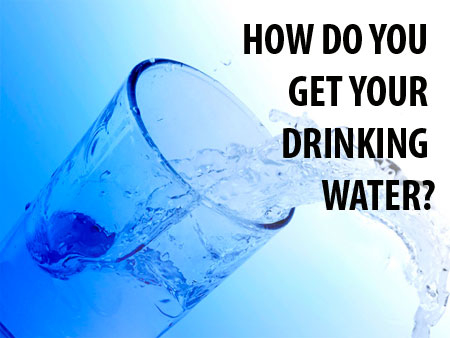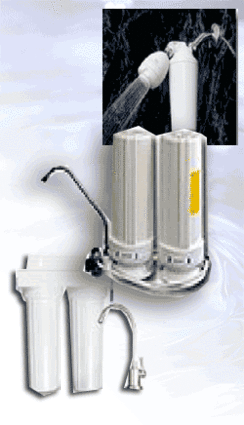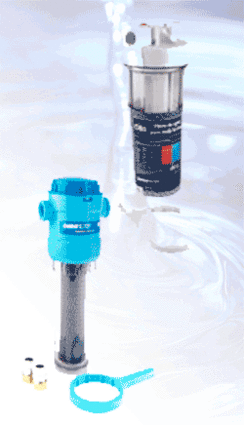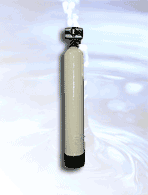Filters
(Editor's note: The following article is the second in a series that began Sept. 26, featuring information on saving and recycling water at home and at work).
The United States enjoys one of the best supplies of drinking water in the world.
This is a fact we often take for granted, although only 1 percent of the world’s water can be used for drinking. Nearly 97 percent o f the world’s water is salty or otherwise undrinkable and the other 2 percent lies in ice caps and glaciers.
Another consideration: There is no new water. Whether our source water is a stream, river, lake spring or well, we are using the same water the dinosaurs used millions of years ago.
Drinking water is a precious commodity. What are the most common methods to get safe water to our tables and conserve it for future generations?
Bottled water
We live in an age when people on the go not only carry their cell phones, but also a bottle of water. The bottled water habit may be an idea born during the heightened awareness of fitness and potential water pollution over the last two or three decades.
Interestingly enough, water has been bottled and sold far from its source for thousands of years. In Europe, water from mineral springs was often thought to have curative powers. Pioneers making their way west across the United States during the 19th century also typically considered drinkable or potable water a staple to be purchased in anticipation of their long journey.
Today, of course, there are dozens of brands of bottled water on the market, and many different kinds, including flavored water to choose. What are the advantages? Is bottled water safer? Does it taste better?
In the United States, the Food and Drug Administration regulates bottled water as a food product under the Federal Food, Drug, and Cosmetic Act (FFDCA). Bottled water manufacturers in the United States must ensure that their products meet the FDA established standard of identity for bottled water products. The Environmental Protection Agency sets the standards for tap and public water.
Bottled water is not necessarily more pure, or more tested, than public tap water. EPA standards for safe public water systems are based on the Safe Drinking Water Act.
There’s a downside to bottled water. Some say it’s less about the water and more about oil. It is estimated that it takes 1.5 million barrels a year to make the plastic water bottles Americans use, plus countless barrels to transport it.
Water treatment at home
Domestic water, as delivered to our house, place of work or other places of public access, would have passed though a network of pipes which conveys the water from its last treatment plant and or storage for distribution. Through this network, new or old, pose possibilities of re-contamination, in varying degrees, depending on the age, type of pipe, degree of cleanliness on last repairs, etc.
In public places, consumers have no control over the quality of available water, perhaps they will taste it before they even try to drink it or simply choose not to drink it at all, and use bottled water instead.
Consumers can have control over the quality of the water they use in their homes.
The type of treatment people choose depends on the typical quality of water that comes into their homes. Although considered safe for domestic use, there are some water supplies that have hard water (caused by dissolved calcium and/or magnesium compounds), some have really soft and some in between. The residual chlorine was there as a disinfectant but beyond that it is not pleasant to the taste. Some waters have odor. These nuisances can be mitigated with water treatment that is commercially available.
Point-of-use filters
If the water entering the house is not whole-house treated, there are types of filters for different places in the house (point of use). For example, there’s one for the shower, one for the kitchen sink faucet and one for the refrigerator — a built-in or in-line type.
Generally for drinking purposes, cartridge filters with filter paper and activated carbon granules will filter out most particles, micro-organisms and other contaminants that affect our health (check the labels) and remove residual chlorine and odor. These are the types that are typically used in drinking water faucet and refrigerators. These cartridge filters need to be replaced frequently, typically recommended every six months. They may have to be replaced sooner when the flow is appreciably reduced.
Whole house cartridge filters
A "whole house" filter is a larger capacity filter than the "points of use" cartridge filters. A filter housing, which has a particulate filter cartridge, may be used in conjunction with another filter housing, which has an activated carbon cartridge, and the two filter housings arranged in series.
Some filter housings have a built-in bypass valve to allow change-out of filter cartridges while allowing water to pass through the filter bypass port. It is recommended that these filter elements be replaced every six months, if used exclusively.
Whole house carbon media filters
Another whole house filter type that does not require six-month replacement (because it is not a cartridge type) is a carbon media filter. It combines sand and
anthracite granules to filter out particles, and a bed of activated carbon granules to remove residual chlorine and odor, inside a cylindrical pressure vessel. It requires a small amount of electrical power to run timers to automatically perform sequence of backwash, rinse and return to normal service operation.
Some designs automatically backwash on a time interval method, while others automatically backwash after a specific metered volume has been passed. The metered version saves more water for those who use less than normal, because they would backwash less often. The backwash operation is essential to allow release of the trapped contaminants to the sewer and allow automatic return to normal filtration service after rinsing.
The usual life span of this type of filter is 10 to 15 years, depending on the amount of water treated. In spite of the filter bed getting backwashed, the backwash process does not do anything to the activated carbon to get rid of absorbed chlorine and the compounds that initially caused the odor in the water.
This type of filter does not reduce water hardness. It is preferable to supplement this filter with a whole house cartridge filter designed to remove micro-organisms, and other contaminants that affect our health (check the labels). This cartridge filter would be located downstream of the carbon filter.
Water softeners
Water softeners are usually whole house water treating units, used to reduce water hardness. Hard water does not make normal lather with a normal amount of regular soap, thereby reducing the ability to clean effectively.The water softener removes the hardness by an ion exchange principle wherein the calcium and magnesium ions are replaced with sodium ions. The resulting sodium compounds are soluble as part of the "softened" water product.
The product is called "soft water" although the dissolved solids are still there. The calcium or magnesium compounds are washed away during the filter backwash cycle. The water softener requires a constant supply of salt for regenerating the depleted resin. In addition, it requires a small amount of electrical power to run timers to automatically perform a sequence of backwash, regeneration, rinse and return to normal service operation.
Water softeners should be used only with utmost consideration to the presence of sodium in the product, and its effect on sodium sensitive people who may drink it. Under normal operations, the amount of sodium in the product water is normally proportional to the water hardness before treatment. Softened water benefits the washing, cleaning and bathing aspects, as well as eliminates calcium build-ups in house piping and counters.
Reverse osmosis
Reverse osmosis (R.O.) Units are a point-of-use filtration type that utilize ultra-filtration elements to achieve high filtration efficiency. R.O. units eliminate most of the dissolved solids (90 percent-96 percent), reducing water hardness without the use of regenerating compounds such as salt. However, R.O. systems tend to waste water, ranging from 33 percent-50 percent of the feed while filtered water is produced.
R.O. units are usually complemented with pre-filters, consisting of a cartridge filter and a carbon filter to extend the life of the ultra-filtration elements and with a Ultraviolet (U.V.) device for disinfection. The pre-filter cartridges are usually replaced every six months, but the ultra-filtration element is replaced less frequently. Most bottled drinking water is produced by means of R.O. systems in industry.
Further information
For more information, go to the Web: EPA
Code of Federal Regulations, 21 CFR Part 129 (bottled water)











